When running an online business, you’ll often hear about EULA and terms and conditions. But what do these terms really mean?
A terms and conditions agreement is like the rule book users agree to follow when they use your website. They govern the use of a website, from what users can and can’t do to how disputes will be resolved.
On the other hand, an End User License Agreement is more specific. EULA is a formal contract that mainly pops up when software is involved. Essentially, an EULA grants the user the right to use the software, detailing how and where it can be used.
To understand how these documents protect both you and your users, let’s talk about the nuances of each and explore when and why your business might need them.
- Both EULAs and terms and conditions are essential for protecting your business and ensuring legal compliance.
- While both are legal agreements, EULAs focus on software usage, while T&Cs govern website usage.
- Instead of writing from scratch, consider using an EULA or T&C generator to make the process easier.
Table of Contents
PRO TIP: Take the hassle of writing your own terms and conditions away with our terms and conditions generator trusted by over 200,000 businesses. It’ll save you hours of work and possible costly legal mistakes.
EULA vs Terms and Conditions
A EULA focuses on granting and limiting user rights for software use, outlining licensing terms and restrictions. Terms and conditions cover broader rules for using a website, service, or product, including payment, liability, and user obligations.
EULAs are software-specific, while terms and conditions apply to various services and platforms. To illustrate this distinction clearly, here’s a comparison table that breaks down their key differences:

The differences between an EULA and terms and conditions primarily revolve around their application and provisions. That said, both are crucial for protecting the interests of businesses across various sectors.
Why Do You Need an End-User License Agreement (EULA) for Your Business?
You need an EULA for your business to establish a clear legal relationship between you and your customers when it comes to using the software that you basically license them to use. Think of it as a digital contract that outlines the rules for how your customers can use your software.
An EULA is essential for several reasons:
- To assert ownership of your software and protect your intellectual property rights
- To limit your liability in case of any issues or disputes related to your software
- To inform users about their rights and responsibilities when using your software
- To comply with legal requirements for distributing software
Let me give you a real-world example. Imagine you’ve created a fantastic new productivity app. You want to share it with the world, but you need everyone to understand the terms and conditions under which they can use it.
An EULA not only grants a user the right to use your software. It also outlines how the app can be used, whether it can be modified, and what happens if there are any problems.
From my own experience, introducing an EULA has streamlined how we manage user rights and expectations. It helped ensure everyone was on the same page, reducing the risk of disputes.
PRO TIP: Always require the user to agree to your EULA before installing or using your software. This shows they understand the terms and are willing to abide by them.
Why Do You Need Terms and Conditions for Your Business?
You need a terms and conditions agreement for your business to set clear rules and guidelines for how customers can use your website, products, and services overall. This entire agreement acts as the fundamental backbone that helps you and your users understand what is expected from each other.
A terms and conditions agreement is used for several reasons:
- To establish the legal basis for the use of your website or application
- To define acceptable use (what is allowed and what isn’t in order to use your services)
- To limit liability
- To clarify payment terms, if applicable, including subscriptions and the consequences of non-payment
- To detail the process for account termination
Similar to an EULA, I recommend requiring users to agree to the terms of the agreement beforehand. Doing so creates a legally enforceable contract that supports fair use and compliance across your platform.
When Do You Need EULA or Terms and Conditions for Your Business?
The difference between terms and conditions and an EULA lies in their focus. The former is primarily for websites, while the latter is specific to software.
You need an EULA:
- When you sell or distribute software products, including desktop applications, games, or mobile apps.
- For software as a service (SaaS) products, where users can use the software hosted on your servers.
You need terms and conditions:
- If you’re providing a service online, like e-commerce, content streaming, or educational platforms.
- When running a website that requires user registration or personal information collection, users know how their data will be used and protected.
In my work with different business models, I’ve noticed that integrating feedback mechanisms within the EULA and T&C can greatly improve user compliance and engagement.
For instance, in my e-commerce ventures, adapting the Terms based on customer interactions and dispute resolutions has helped refine our operations and reduce legal snags.
This process ensures that as the market evolves, so do our practices, keeping us ahead of potential challenges and aligned with customer expectations.
Common Clauses That Appear in Both EULA and Terms and Conditions
While EULAs and T&Cs serve distinct purposes, there are several common clauses that often appear in both types of agreements. Here are some of these shared elements:
Parties
Both an EULA and T&C act as a contract between a software or service provider and the user. The “Parties” clause is where you specify the legal entities (individuals, companies, or organizations) bound by the terms of this agreement.
Here’s a sample clause from iHome Clean’s mobile app EULA:

Here’s a sample “Parties” clause from The Roadmap’s Terms and Conditions page:

Having a clear “Parties” clause delineates who exactly is responsible and accountable under the agreement.
For the business, this means there’s a straightforward understanding of who their customers are and that the rights and obligations set forth in the agreement are enforceable against the correct parties.
For users, this clarifies that they are entering into a contractual relationship with a specific provider.
Definitions
This serves to clarify the meaning of key terms used throughout the document. It is especially crucial when distinguishing the nuances in EULA vs ToS (Terms of Service), as each term can have specific implications depending on the context.
Here’s how Relevant Solutions, LLC approached this in its T&C document:
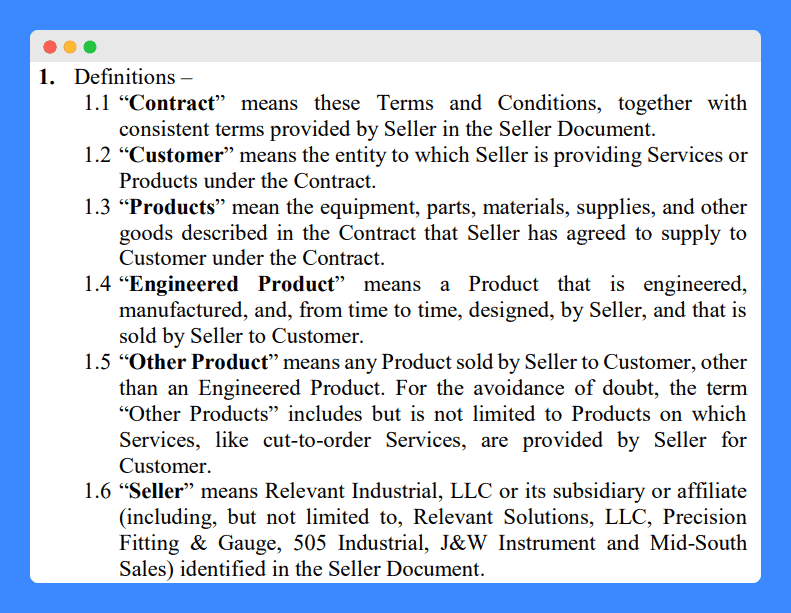
In my experience, clearly defined terms are easier to enforce in a legal context. That’s because there is a mutual agreement on what each specified term means. They also help minimize misinterpretations that could lead to misunderstandings.
Other Agreements
This clause specifies how the agreement in question interacts with other policies that may also apply to the user. It clarifies the hierarchy and integration of various agreements a user must consider when using software or services.
Here’s an example of this clause from Pison Technology:

By including this clause in its EULA, Pison Technology ensures that its users are aware of all the legal documents they are bound by. In turn, it’s able to maintain order and consistency in its legal relationships.
Disclaimer of Warranties
Here’s where the service provider explicitly states that the services or products are provided “as is,” without any guarantees about their performance, quality, or suitability for a particular purpose.
Here’s a snippet of Zoomd’s T&C that includes this section:
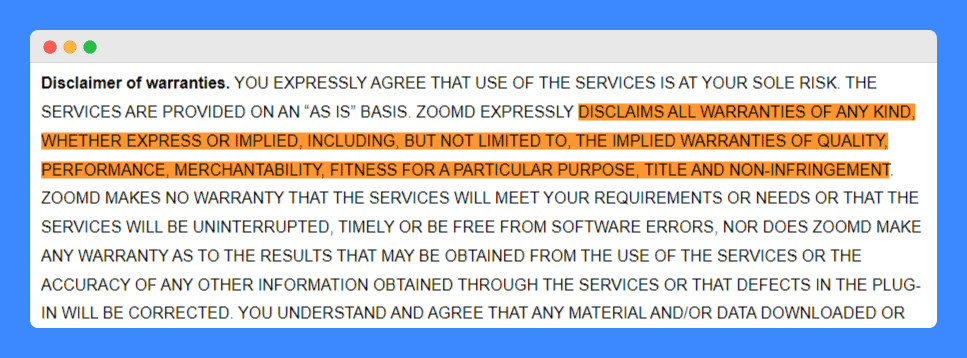
Through this clause, Zoomd is able to limit liability in case its service or website fails to meet the user’s expectations or incurs unexpected issues. It sets realistic expectations for users, making them aware that they use the service or website at their own risk.
That said, some states and jurisdictions might restrict the enforceability of “as is” clauses. But this doesn’t mean your hands are tied.
It’s a good practice to include a clause that automatically adjusts the terms based on the user’s jurisdiction. This not only ensures compliance across different areas but also maintains the integrity of your legal protections without constant manual updates.
Limitation of Liability
While the Disclaimer of Warranties addresses the quality and performance expectations, the limitation of liability explicitly restricts the financial responsibility that could be incurred.
Here’s an example of this section from Acquire’s EULA:

This clause ensures that if something goes wrong, the company’s exposure to claims is kept to a minimum. In most cases, it’s often equivalent to the amount the user has paid for the service or a predetermined limit.
Governing Law
This clause lets both parties know under which legal framework any disputes will be resolved. With a clear path for legal proceedings, you can prevent jurisdictional conflicts that could end up in court.
Let’s look at Jotform, for example:
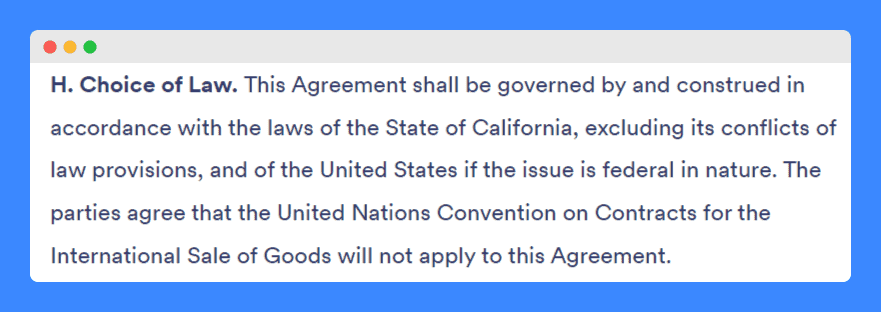
Since they cater to a diverse international user base, having this clause helps ensure that both Jotform and its users are on the same page legally, regardless of where they are located.
User Guidelines
This clause lays down the rules for how users should interact with the offerings. When users agree to follow your rules, they’re committing to using your services in a way that respects your terms, the integrity of the service, and the rights of other users.
Always make sure the user has accepted the agreement by taking an active step, such as checking an “I Agree” box. This makes it clear they are allowed to use your services only if they follow your rules.
In other cases, like in MidMetric’s, simply accessing and/or continuing to use the site means the user agrees to the terms:

Clauses Unique to EULA
While there are clauses common to both, there are also some elements that are more specific to EULAs. Here are some common EULA clauses you might encounter:
Grant of Licenses
This part is where the provider officially grants the user a license to use the software. Through this clause, both parties are able to understand the extent of the software license and any restrictions that apply.
Take a look at Workpoint 365’s EULA, for instance:

Here, it’s clear that users can use the software only for personal purposes and cannot resell or transfer it to others. By adding this clause, Workpoint 365 is able to maintain control over its intellectual property.
Limitations on Use
Your EULA should specify what users are prohibited from doing with the software. This is so that it does not get exploited in ways that could harm you, the provider, or violate legal regulations.
For example, in Certus Erasure’s EULA, the limitations on use are clearly laid out. The clause states:
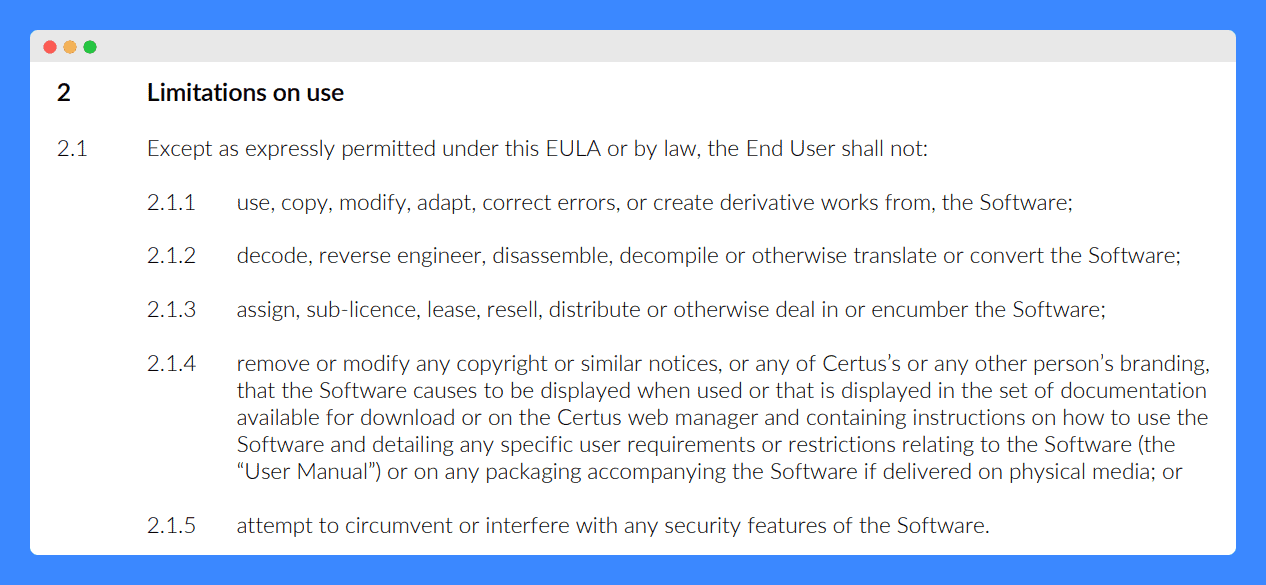
In my professional opinion, the EULA should also include any geographical restrictions, specific use cases that are prohibited, and technical restrictions, like limitations on the number of installations.
Doing this helps users understand that they must use the software only within the scope of the license provided.
Again, you can ask them to agree to the license terms by clicking an “I agree” checkbox. Being very specific about how users accept the EULA also makes the terms more transparent and enforceable.
PRO TIP: Strategically place your EULA within easy reach like the footer or during signup. This encourages informed consent from users.
Termination Conditions
In an EULA, this section outlines the circumstances under which the licensing agreement can be terminated.
The terms of the EULA typically include conditions such as breach of agreement, illegal use of the software, or other violations that might jeopardize its integrity or the provider’s legal standing.
For example, RunSensible’s EULA includes a clause stating that the user may have their license revoked under certain conditions:

This approach ensures that the use of the software remains strictly within the agreed-upon legal and ethical boundaries.
PRO TIP: To save time and legal fees, you can use a reliable EULA generator. These tools ensure your agreement is comprehensive and up-to-date.
Clauses Unique to Terms and Conditions
For the smooth and legally secure operation of your online platform, you need the following terms and conditions clauses:
Acceptance of Terms
This clause outlines how users can formally acknowledge and agree to comply with the terms set forth by a service or website.
In ISO’s terms and conditions, for example, users are required to tick a box stating they have read, understood, and agree with the terms.
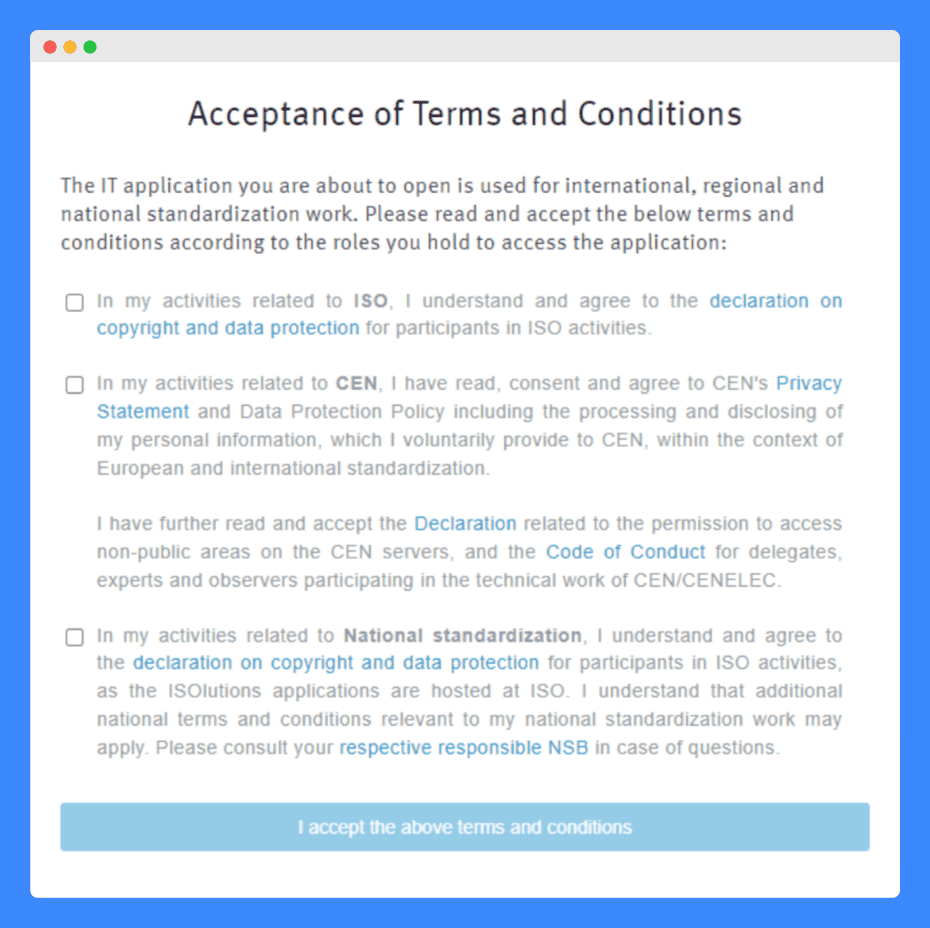
When you obtain acceptance of your terms this way, you create a binding agreement between you and your target audience.
Payment Details
This part specifies the terms of payment, including accepted methods, payment schedules, and any penalties for late payments. This way, users understand their financial obligations and the consequences of non-compliance.
For example, Nature.com includes such a clause in its terms and conditions to clarify how subscriptions and access fees are handled.
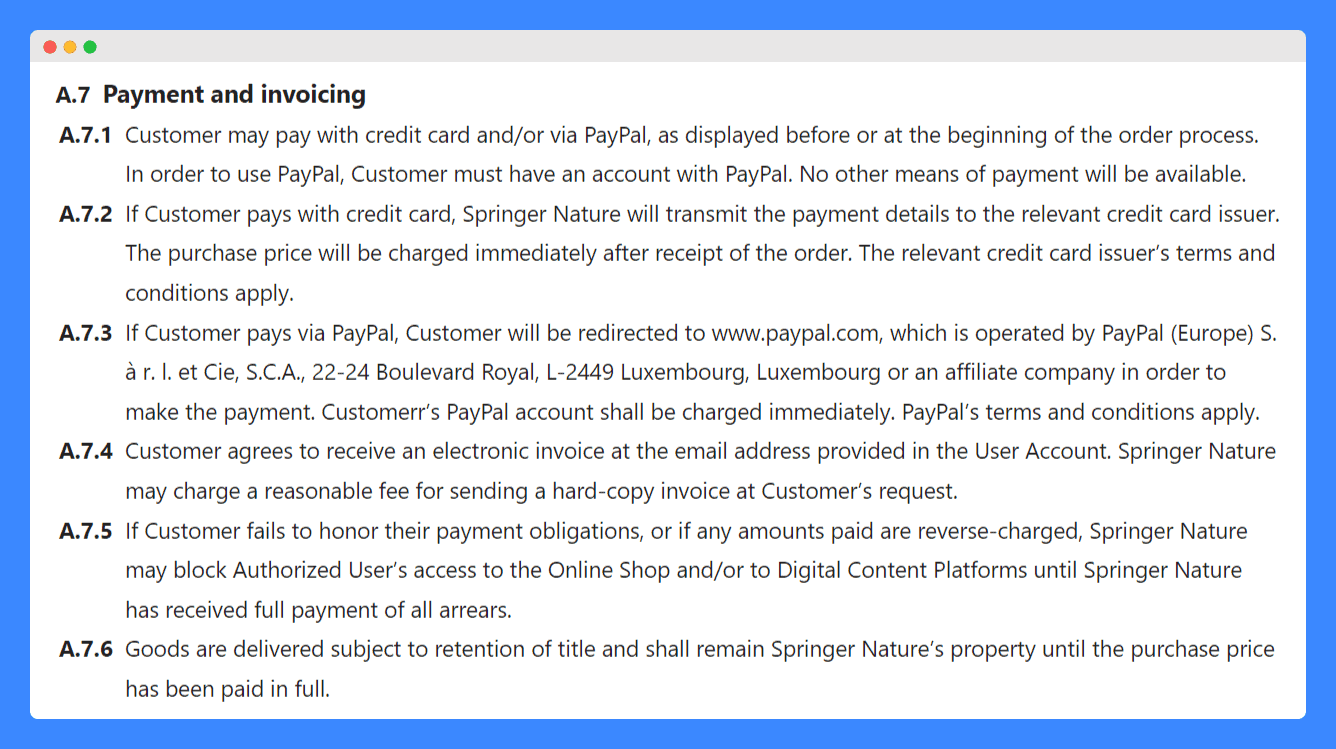
By outlining these details, their users are now fully aware of their financial commitments when they subscribe or purchase access.
Account Termination and Suspension
Here’s where you specify the conditions under which a user’s account may be suspended or terminated, as well as how they may voluntarily terminate their account if they wish to do so.
Ninetailed.io includes such guidelines in its Terms of Use agreement:
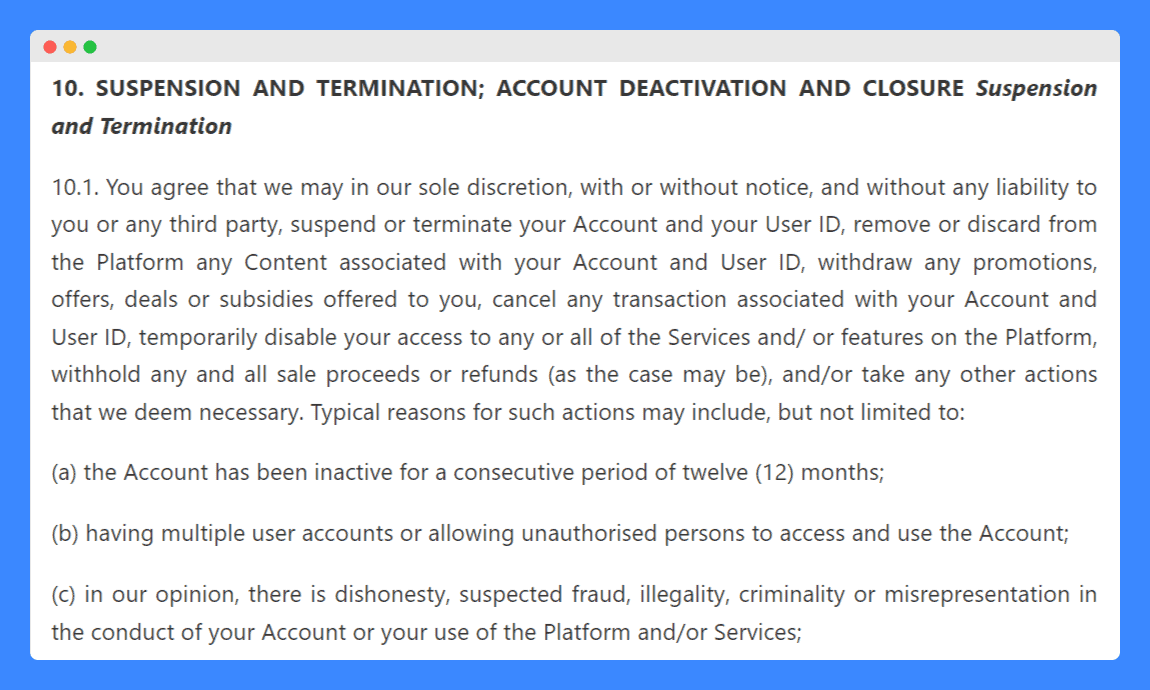
It says that the company reserves the right to suspend or delete accounts for behavior that may breach the agreement, like inappropriate or offensive actions.
Moreover, it clarifies that such terminations or suspensions do not entitle users to any compensation. This reinforces the consequences of failing to adhere to the terms, especially when the issues or service disputes are attributable to the user’s actions.
Copyright Infringement
This clause protects the rights of the copyright holders and the rights of the users to use the service. It provides a clear procedure for addressing instances where copyright infringement is alleged, so all parties understand how such claims are to be handled.
Activision includes a comprehensive section in its Terms of Use that details this process:

This section not only specifies how claims should be presented but also includes precise contact details such as an exact address, fax number, and email to facilitate communication.
PRO TIP: Streamline your policy creation using a terms and conditions generator. It’s a quick way to tailor legal terms specific to your business needs.
Frequently Asked Questions
Are EULAs legally binding like Terms and Conditions?
Yes, EULAs are legally binding like terms and conditions when users agree to them before use. Both set enforceable rules and rights.
Do I need both an EULA and a Terms and Conditions for my mobile app?
For a mobile app, having both an EULA and terms and conditions is advisable. They cover usage rights and general policies respectively.
Can I combine EULA and Terms and Conditions into one document?
Yes, you can combine EULA and terms and conditions into one document. Just make sure to keep each section clear and distinct.
What clauses in an EULA are essential for protecting my business?
Essential EULA clauses include license grants, usage restrictions, and intellectual property rights to protect your business.
How often should I update my EULA and Terms and Conditions?
Review and update your EULA and terms and conditions annually or when your services or legal standards change.
Do both EULA and Terms and Conditions address privacy and data security?
EULA and terms and conditions can address privacy and data security, but they are more common in terms and conditions.
Should I localize my EULA and Terms and Conditions for different markets?
If you’re asking, “Are EULAs enforceable under local laws?” then yes. Localizing EULAs and T&C ensures relevance across markets.



